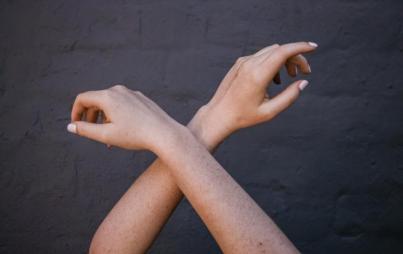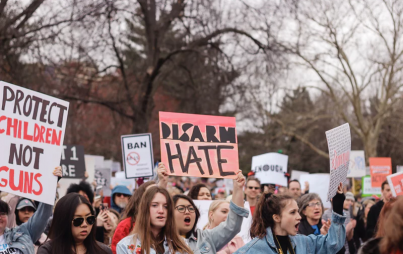
I love horror movies. Also, I’m a feminist. (Image: Netflix)
I love horror movies. Also, I’m a feminist. This is a problem, though not an uncommon one. As many feminist cinephiles know, women in horror movies are victimized, brutalized, and denied agency on a regular basis — especially in subgenres like slashers (Nightmare on Elm Street, Halloween, and Friday the 13th are classics of this genre) and “torture porn” (the entire Saw franchise falls into this category). These movies normalize, sometimes even glorify, violence against women. What’s a girl to do, except join the ever-growing ranks female-identifying horror fans who ask themselves: “can horror movies be feminist?” My answer is an unequivocal yes.
In fact, I’d argue that some of the most progressive female-centered films of the modern day are classified either as horror or as horror’s less-gory-but-equally-suspenseful cousin, the thriller. If you’d like to acquaint yourself with some horror movies that don’t treat women like passive victims, I recommend starting with the ones on this list. The following six movies feature complex, flawed heroines and they’re all currently available for instant streaming on Netflix:
6. The Awakening (USA, 2011)
Before Lorraine Warren, the psychic myth-debunker from 2013’s The Conjuring, there was Florence Cathcart, a badass, myth-debunking scientist from 1920s England. That’s right. Scientist. Florence’s primary goal in life, and throughout the movie, is to disprove all supernatural phenomena, particularly ghosts, with science. And unlike Lorraine, she does it by herself (rather than in her husband’s shadow), while steadfastly ignoring every bit of side-eye thrown her way by condescending, pipe-smoking gentlemen.
This is primarily a ghost story, so when she gets hired to investigate a boys’ home in the middle of nowhere, the place is actually haunted. The movie’s atmosphere adds to its overall creepiness — think Crimson Peak, but grayer and more oppressive — and the setting functions like its own character. But make no mistake, this is Florence’s movie from beginning to end: her history, her beliefs, and even her perceptions of reality are at the heart of the story.
5. Housebound (New Zealand, 2014)
This horror-comedy gem from New Zealand appears to be relatively little-known, and that’s a shame because it straddles both genres seamlessly. I laughed harder at this movie than any other horror flick I’ve seen, but the film also delivers scenes filled with genuine tension and a couple of creative scares. Kylie Bucknell, the super-relatable teenaged protagonist, is put under house arrest and forced to live for a few months in the same house as her estranged mom and new stepdad. All that would be bad enough, except that there’s also a ghost haunting the place. Probably. Or maybe there isn’t, and it’s all in Kylie’s head.
Refreshingly, the movie uses the “there’s no such thing as ghosts” concept to make a statement about who believes women when they “tell stories.” Kylie’s mom is also a significant player in the action, and the movie makes a point to highlight how mother and daughter learn to trust each other and repair their bond, making this one of the few horror films I can recall that actively focuses on the development of a mother-daughter relationship.
4. It Follows (USA, 2014)
Most horror movies, particularly slashers, reflect narrowly puritan attitudes about sex, i.e., virgins are Perfect and Pure, and women should be punished for promiscuity. It Follows throws this narrative into question by turning its monster into an STD. The heroine, Jaime (Jay) Height contracts an “illness” when she has sex for the first time and is informed that a monster is now out to get her. Said monster could look like anyone — someone she knows or doesn’t — and it’ll follow her until it kills her… unless she passes it on by having sex with someone else.
This premise neatly captures a lot of universal fears about sex and sexually transmitted diseases, and almost everyone can relate to the worry of “catching something” from an unprotected partner. Since the (presumably) heterosexual Jay literally has to be “saved” by a man’s penis, it would be easy for her character to be “damseled” in this narrative. But she’s not. She’s a stubborn, independent protagonist who often resists help from her friends in favor of trying to solve the problem on her own instead. It’s also clear from the start that Jay has serious ethical concerns about “passing on” the monster to someone else, even when she is surrounded by several willing partners, and the movie is ultimately less about who will save her and more about how she’ll use her resources to save herself.
3. The Babadook (Australia, 2014)
No list of female-centric horror movies would be complete without the critically-acclaimed (and female-directed) Australian hit, The Babadook. The story itself is simple: after the death of her husband, grieving mother Amelia Vanek and her traumatized, badly-behaved son Sam are terrorized by a demon connected to a disturbing pop-up book that mysteriously appears on Sam’s shelf.
At first glance, the structure of the story seems like the typical arc of a demonic possession movie: the demon shows up, the demon teases, taunts, and terrifies a family and then, in the third act, the demon possesses a kid or an adult until somebody calls an exorcist or demonologist (see also: The Exorcist, The Rite, The Conjuring, etc.). But the revolutionary thing about this particular take on the trope is that the Babadook isn’t your run-of-the-mill demon. It doesn’t have an association with a specific religion; there’s no expert Amelia can call, other than regular doctors, who wildly ineffective. Instead, Amelia and Sam are left to fight a monster of their own creation, one made of grief and resentment. More than anything else, The Babadook is about motherhood, and all the unseen burdens mothers carry around with them every day, and that makes the film far scarier than typical possession-movie fare.
2. The Craft (USA, 1996)
This oldie but goodie is so 90s, which you can tell because this movie, like the 90s, is chock full of witches. Strange things begin to happen to Sarah Bailey practically the moment she moves to Los Angeles. (Example: five minutes after she steps into her new house, a creepy guy comes at her with a snake laced through his hands saying don’t you want it? The sexual harassment allegories are strong with this one.) But “strange” doesn’t even begin to cover what happens after Sarah falls in with a group of high school witches and becomes the fourth member of their coven.
In a way, the girls’ magic is a metaphor for that deep, heady friendship experienced so often by girls in high school. There’s an inexplicable authenticity in watching a cadre of teenage witches make glamours and play light-as-a-feather, stiff-as-a-board. But similarly authentic is the way everything turns remarkably sour, remarkably quickly. Because of a boy. Of course. I love this movie for how accurately it portrays the ups and downs of female friendship: there’s an unflinching willingness to show both how women can choose to build each other up and the uniquely destructive ways they can (literally) curse each other into isolation.
1. Hush (USA, 2016)
Home invasion movies trade in a particular kind of fear: the universal discomfort associated with somebody breaking into your house and violating a supposedly safe space. But horror movies often engage with the same tropes from a bunch of different angles, so most home invasion movies nowadays have a built-in twist, like the themes of class warfare in The Purge.
In keeping with this trend, Hush has the highest stakes I’ve ever seen in a home invasion movie: not only is the protagonist, Maddie, alone in her cabin in the woods, she’s also Deaf, and can neither hear nor speak. When a masked-hunter whose very existence embodies toxic masculinity decides to play a game of cat and mouse with her, Maddie must rely on bravery and cleverness to stay alive and to fight back.
Movies like these six prove that, despite its history, horror movies can be a fruitful avenue for feminist art. Granted, horror still has a long way to go in terms of intersectional feminism: all of these heroines on this list are white, and we definitely need some more kickass horror-movie heroines of color in our theaters and on Netflix ASAP. I have faith, though, that the horror genre will catch up to its feminist audience sooner rather than later. If the recent success of the excellent horror-comedy Happy Death Day is any indication, female-centered horror movies might be on the rise.





![By Magicland9 [CC BY-SA 3.0 (https://creativecommons.org/licenses/by-sa/3.0)], from Wikimedia Commons By Magicland9 [CC BY-SA 3.0 (https://creativecommons.org/licenses/by-sa/3.0)], from Wikimedia Commons](/sites/default/files/styles/profile/public/images/article/2019-06/Bell.png?itok=gWp6s_Y0)


